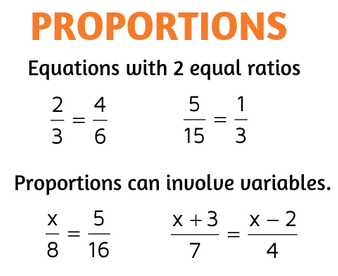Unit 7 Lesson 1 Ratios and Proportions
Unit 7 Lesson 1: Ratios and Proportions

Lesson Overview
Ratios and Proportions
What You Will Learn
- writing ratios and solving proportions
Overview
In this lesson, you will learn to write ratios and solve proportions.
Essential Understanding
You can write a ratio to compare two quantities. A ratio is a comparison of two quantities by division. You can write the ratio of two numbers, a and b, where b ≠ 0, in three ways: a/b, a:b, and a to b. You usually express a and b in the same unit and write the ratio in the simplest form. An extended ratio compares three (or more) numbers. In the extended ratio a : b : c, the ratio of the first two numbers is a : b, the ratio of the last two numbers is b : c, and the ratio of the first and last numbers is a : c.
Throughout this lesson, you will learn key terms and vocabulary. Write these words down in your journal, and write their definitions as you come across them. They are listed to the right.
This course is based on a textbook that is viewable by clicking on the textbook icon. Keep the textbook open while you go through the lesson so that you may refer to it throughout the lesson.

Lesson 1: Ratios and Proportions
Proceed to the Next Page
Prepare for Application
Instructions
You have now studied Ratios and Proportions. It is now time to demonstrate your learning.
Try the activities below on your own. You should be able to answer these before beginning the practice.
Do these activities in your journal.
Activity 1
A bonsai tree is 18 in. wide and stands 2 ft. tall. What is the ratio of the width of the bonsai to its height?
Activity 2
The measures of two supplementary angles are in the ratio 1 : 4. What are the measures of the angles?
Activity 3
The lengths of the sides of a triangle are in the extended ratio 4 : 7 : 9. The perimeter is 60 cm. What are the lengths of the sides?
Activity 4
What is the solution of each proportion?
Activity 5
For 1-2, use the proportion . What ratio completes the equivalent proportion? Justify your answer.
1.
2.
3. Explain why is an equivalent proportion to .


